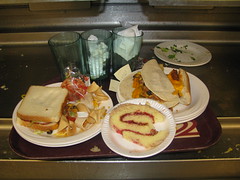Why remove trays from “all-you-can-eat” cafeterias? To avoid the routine piles of food waste.
In April, a student-led campaign at Virginia Tech weighed food waste for a week as a baseline for comparison to a week without trays. What they found, might startle you. Have a look. (Photos courtesy of VT Dietetic Intern Andy Sarjahani, the campaign organizer.)
 In addiction terms, trays enable waste. By allowing students to pile on more food than they could possibly consume, trays encourage the sampler strategy and the giant eyes, small stomach syndrome.
In addiction terms, trays enable waste. By allowing students to pile on more food than they could possibly consume, trays encourage the sampler strategy and the giant eyes, small stomach syndrome.
Not that the slabs of plastic alone are the problem. Rather, it’s the combination of the tray and “all-you-can-eat” facility that yields massive waste. (And I suppose students themselves share some of the blame.) But reformers are pushing for trayless cafeterias because the “all-you-care-to-eat” (in diningspeak) model is entrenched.
Over the week, Techies averaged about a half-pound (0.47 lbs) of edible waste per student per meal and 1,400 pounds of compostable waste per day. (The student sorters separated edible leftovers from inedible items like banana peels.) Sadly, that number isn’t much higher than results at other schools.
Next week, we’ll look at what happened when Virginia Tech removed the trays. Until then, I’m curious if this topic brings back memories from your school days? Also, are there any factors that contribute to food waste at your school or workplace?
18 Comments